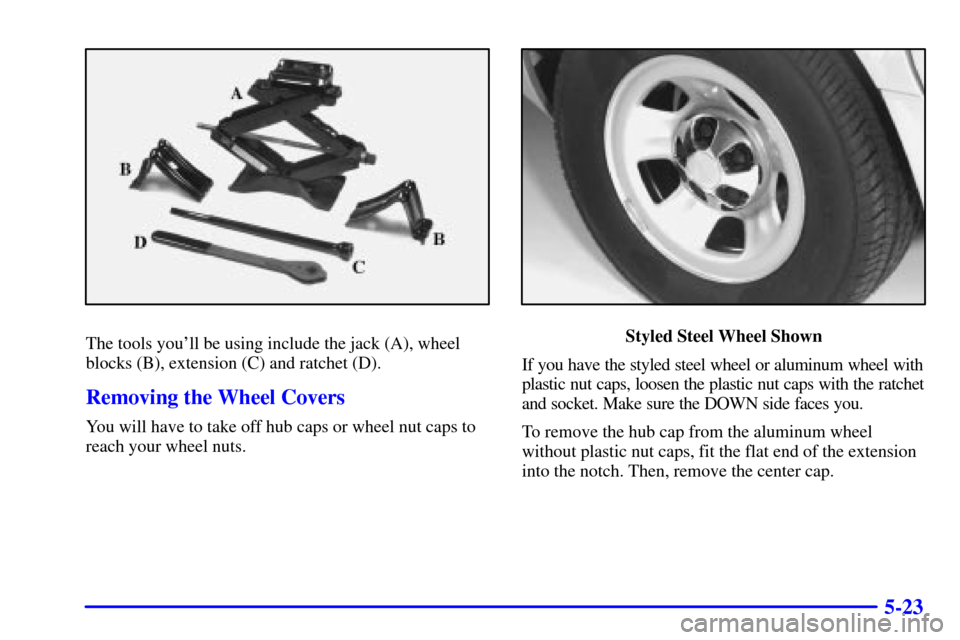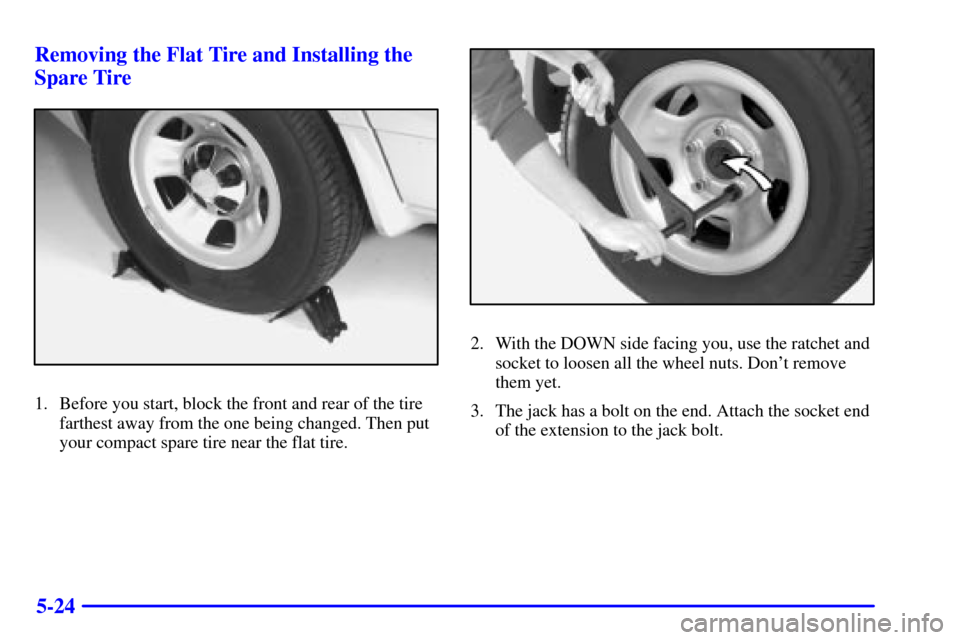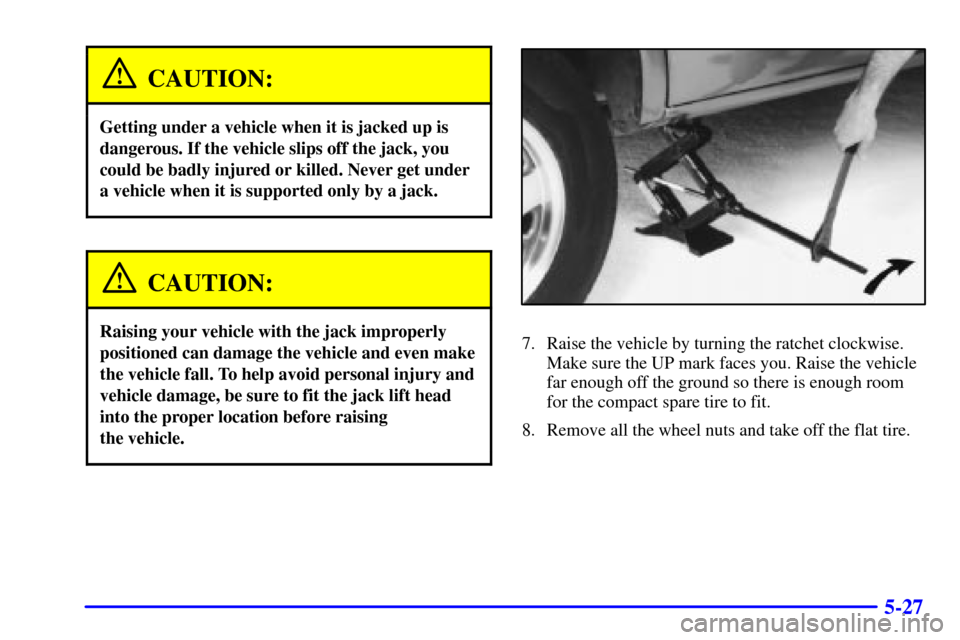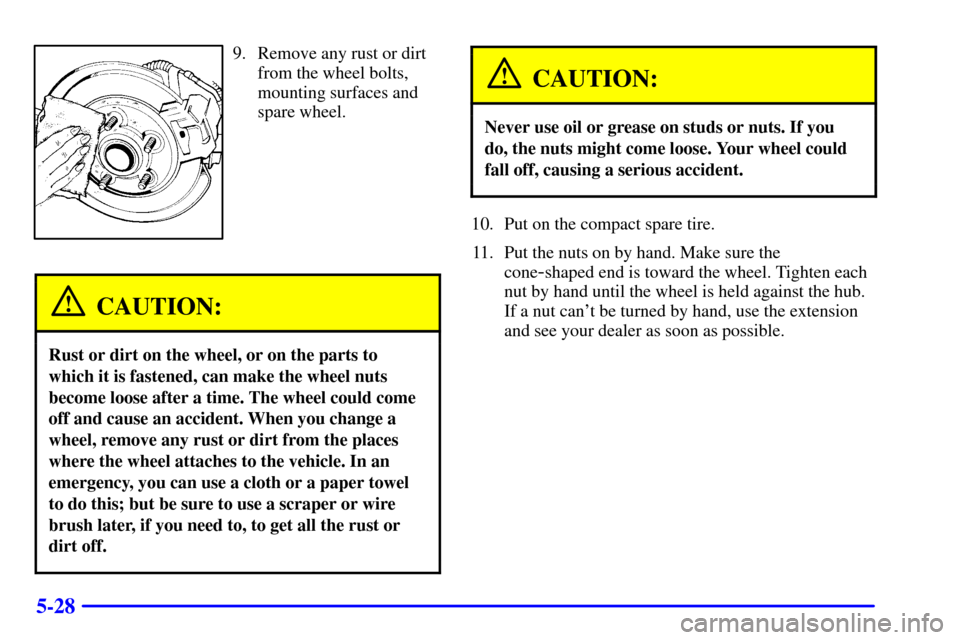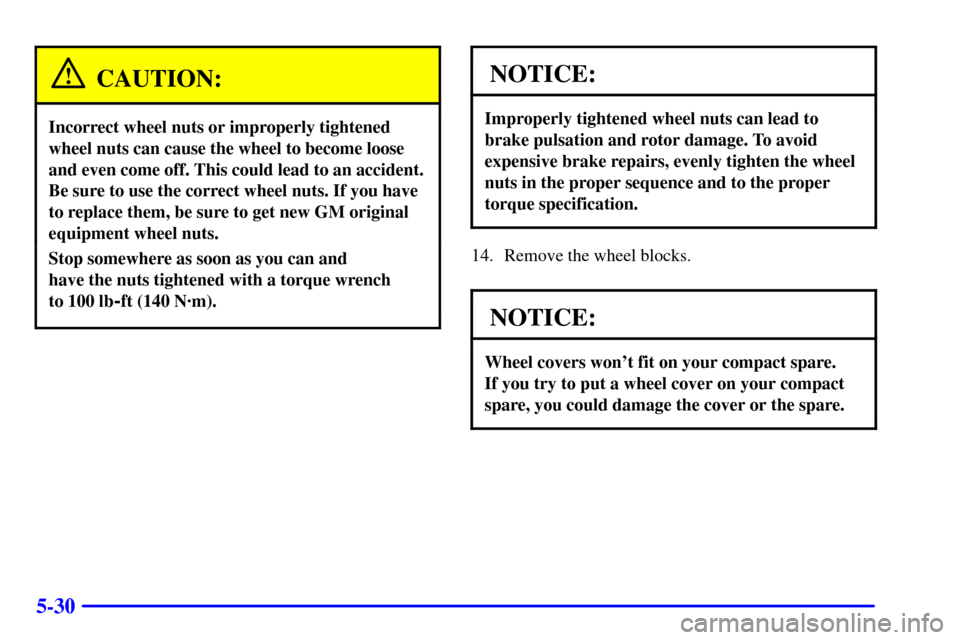CHEVROLET ASTRO CARGO VAN 2001 2.G Owners Manual
ASTRO CARGO VAN 2001 2.G
CHEVROLET
CHEVROLET
https://www.carmanualsonline.info/img/24/8007/w960_8007-0.png
CHEVROLET ASTRO CARGO VAN 2001 2.G Owners Manual
Trending: wheel bolts, battery location, low beam, snow chains, oil change, flat tire, fuel reserve
Page 241 of 388
5-23
The tools you'll be using include the jack (A), wheel
blocks (B), extension (C) and ratchet (D).
Removing the Wheel Covers
You will have to take off hub caps or wheel nut caps to
reach your wheel nuts.
Styled Steel Wheel Shown
If you have the styled steel wheel or aluminum wheel with
plastic nut caps, loosen the plastic nut caps with the ratchet
and socket. Make sure the DOWN side faces you.
To remove the hub cap from the aluminum wheel
without plastic nut caps, fit the flat end of the extension
into the notch. Then, remove the center cap.
Page 242 of 388
5-24 Removing the Flat Tire and Installing the
Spare Tire
1. Before you start, block the front and rear of the tire
farthest away from the one being changed. Then put
your compact spare tire near the flat tire.
2. With the DOWN side facing you, use the ratchet and
socket to loosen all the wheel nuts. Don't remove
them yet.
3. The jack has a bolt on the end. Attach the socket end
of the extension to the jack bolt.
Page 243 of 388
5-25
4. Attach the ratchet to the extension with the UP side
facing you.
5. Turn the ratchet clockwise. That will raise the jack
lift head a little.6. Position the jack under the vehicle.
Page 244 of 388
5-26
Front Position
A. Front Jack Location
B. Jack
C. Ratchet and ExtensionRear Position
A. Rear Jack Location
B. Jack
C. Ratchet and Extension
Page 245 of 388
5-27
CAUTION:
Getting under a vehicle when it is jacked up is
dangerous. If the vehicle slips off the jack, you
could be badly injured or killed. Never get under
a vehicle when it is supported only by a jack.
CAUTION:
Raising your vehicle with the jack improperly
positioned can damage the vehicle and even make
the vehicle fall. To help avoid personal injury and
vehicle damage, be sure to fit the jack lift head
into the proper location before raising
the vehicle.7. Raise the vehicle by turning the ratchet clockwise.
Make sure the UP mark faces you. Raise the vehicle
far enough off the ground so there is enough room
for the compact spare tire to fit.
8. Remove all the wheel nuts and take off the flat tire.
Page 246 of 388
5-28
9. Remove any rust or dirt
from the wheel bolts,
mounting surfaces and
spare wheel.
CAUTION:
Rust or dirt on the wheel, or on the parts to
which it is fastened, can make the wheel nuts
become loose after a time. The wheel could come
off and cause an accident. When you change a
wheel, remove any rust or dirt from the places
where the wheel attaches to the vehicle. In an
emergency, you can use a cloth or a paper towel
to do this; but be sure to use a scraper or wire
brush later, if you need to, to get all the rust or
dirt off.
CAUTION:
Never use oil or grease on studs or nuts. If you
do, the nuts might come loose. Your wheel could
fall off, causing a serious accident.
10. Put on the compact spare tire.
11. Put the nuts on by hand. Make sure the
cone
-shaped end is toward the wheel. Tighten each
nut by hand until the wheel is held against the hub.
If a nut can't be turned by hand, use the extension
and see your dealer as soon as possible.
Page 247 of 388
5-29
12. Lower the vehicle by turning the ratchet
counterclockwise. Lower the jack completely.
13. Tighten the wheel
nuts firmly in a
crisscross sequence
as shown. Turn the
ratchet clockwise
with the UP mark
facing you.
Page 248 of 388
5-30
CAUTION:
Incorrect wheel nuts or improperly tightened
wheel nuts can cause the wheel to become loose
and even come off. This could lead to an accident.
Be sure to use the correct wheel nuts. If you have
to replace them, be sure to get new GM original
equipment wheel nuts.
Stop somewhere as soon as you can and
have the nuts tightened with a torque wrench
to 100 lb
-ft (140 N´m).
NOTICE:
Improperly tightened wheel nuts can lead to
brake pulsation and rotor damage. To avoid
expensive brake repairs, evenly tighten the wheel
nuts in the proper sequence and to the proper
torque specification.
14. Remove the wheel blocks.
NOTICE:
Wheel covers won't fit on your compact spare.
If you try to put a wheel cover on your compact
spare, you could damage the cover or the spare.
Page 249 of 388
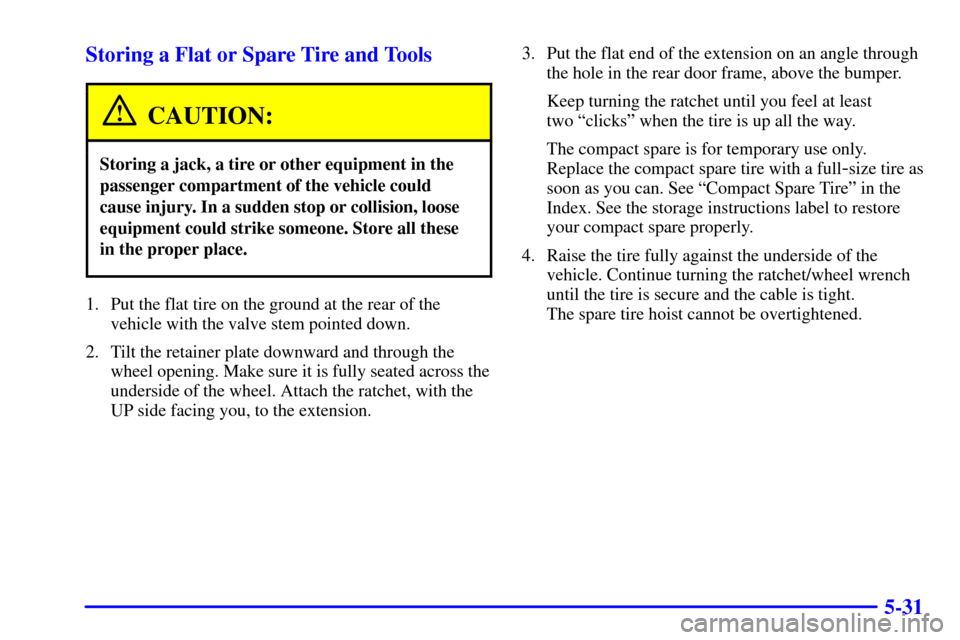
5-31 Storing a Flat or Spare Tire and Tools
CAUTION:
Storing a jack, a tire or other equipment in the
passenger compartment of the vehicle could
cause injury. In a sudden stop or collision, loose
equipment could strike someone. Store all these
in the proper place.
1. Put the flat tire on the ground at the rear of the
vehicle with the valve stem pointed down.
2. Tilt the retainer plate downward and through the
wheel opening. Make sure it is fully seated across the
underside of the wheel. Attach the ratchet, with the
UP side facing you, to the extension.3. Put the flat end of the extension on an angle through
the hole in the rear door frame, above the bumper.
Keep turning the ratchet until you feel at least
two ªclicksº when the tire is up all the way.
The compact spare is for temporary use only.
Replace the compact spare tire with a full
-size tire as
soon as you can. See ªCompact Spare Tireº in the
Index. See the storage instructions label to restore
your compact spare properly.
4. Raise the tire fully against the underside of the
vehicle. Continue turning the ratchet/wheel wrench
until the tire is secure and the cable is tight.
The spare tire hoist cannot be overtightened.
Page 250 of 388
5-32
5. Make sure the tire is stored securely. Push, pull, and
then try to rotate or turn the tire. If the tire moves,
use the ratchet/wheel wrench to tighten the cable.
Return the jacking equipment to its proper location.
Compact Spare Tire
Although the compact spare tire was fully inflated when your
vehicle was new, it can lose air after a time. Check the
inflation pressure regularly. It should be 60 psi (420 kPa).
After installing the compact spare on your vehicle, you
should stop as soon as possible and make sure your spare
tire is correctly inflated. The compact spare is made to
perform well at speeds up to 65 mph (105 km/h) for
distances up to 3,000 miles (5 000 km), so you can finish
your trip and have your full
-size tire repaired or replaced
where you want. Of course, it's best to replace your spare
with a full
-size tire as soon as you can. Your spare will last
longer and be in good shape in case you need it again.
Trending: dimensions, engine, headrest, mirror controls, fuse box, towing capacity, keyless
